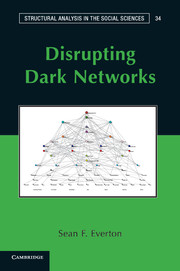Book contents
- Frontmatter
- Contents
- Figures
- Tables
- Preface
- Acknowledgments
- Part I Introduction
- Part II Social Network Analysis: Techniques
- Part III Social Network Analysis: Metrics
- 5 Network Topography
- 6 Cohesion and Clustering
- 7 Centrality, Power, and Prestige
- 8 Brokers, Bridges, and Structural Holes
- 9 Positions, Roles, and Blockmodels
- Part IV Social Network Analysis: Advances
- Part V Conclusion
- Appendix 1 The Noordin Top Terrorist Network
- Appendix 2 Glossary of Terms
- Appendix 3 Multidimensional Scaling with UCINET
- Appendix 4 The Just War Tradition
- References
- Index
9 - Positions, Roles, and Blockmodels
Published online by Cambridge University Press: 05 April 2013
- Frontmatter
- Contents
- Figures
- Tables
- Preface
- Acknowledgments
- Part I Introduction
- Part II Social Network Analysis: Techniques
- Part III Social Network Analysis: Metrics
- 5 Network Topography
- 6 Cohesion and Clustering
- 7 Centrality, Power, and Prestige
- 8 Brokers, Bridges, and Structural Holes
- 9 Positions, Roles, and Blockmodels
- Part IV Social Network Analysis: Advances
- Part V Conclusion
- Appendix 1 The Noordin Top Terrorist Network
- Appendix 2 Glossary of Terms
- Appendix 3 Multidimensional Scaling with UCINET
- Appendix 4 The Just War Tradition
- References
- Index
Summary
Introduction
In Chapter 1, we noted that social network analysts tend to analyze network data in one of two ways: (1) a relational approach or (2) a positional approach (Emirbayer and Goodwin 1994). The former focuses on the direct and indirect ties between actors and seeks to explain behavior and social processes in light of those ties. It highlights the importance of the topography of networks, the centrality of actors, the cohesiveness of subgroups, and the brokers and bridges between such groups. Up to this point, we have essentially focused on the relational approach of social network analysis. In this chapter, we shift gears and explore the positional approach. It differs from the relational approach in that rather than focusing on the ties between actors, it seeks to identify actors who hold similar positions in the social structure. Why are positions seen as important? A position (e.g., student) is typically connected to a particular role or set of roles (e.g., attending class, writing papers, studying for exams) and located within a larger system of positions (e.g., fellow students, professors, staff, administrators). Consequently, some social network theorists argue that actors occupying a particular position/role will be embedded in a similar pattern of ties and exhibit similar types of behavior.
Actors who hold such equivalent positions are said to be structurally equivalent. A set of structurally equivalent actors is referred to as a “block,” and the process by which blocks are identified is referred to as blockmodeling (White, Boorman, and Breiger 1976). Be aware that the terminology in this theoretical area can at times be conceptually confusing because the algorithms that analysts have developed to identify structurally equivalent actors vary in their assumptions and names. For example, structural, automorphic, and regular equivalence algorithms all seek to identify actors who occupy similar positions in the social structure, but they differ in their assumptions of what constitutes a set of equivalent actors and as such identify different sets or blocks (we will explore these differences in detail). Once the blocks of a network have been identified, this information can be used in different ways. For example, analysts can simplify (i.e., collapse) a network based on the sets to which each actor belongs (similar to how we simplified networks using role data in Chapter 4) to see if patterns emerge that were not immediately obvious when looking at all of the actors in the network.
- Type
- Chapter
- Information
- Disrupting Dark Networks , pp. 286 - 316Publisher: Cambridge University PressPrint publication year: 2012



